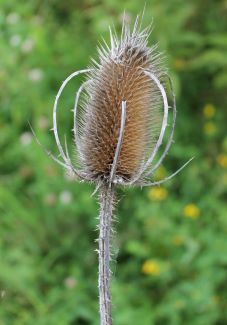By Bob Confer
One of the more unusual-looking wildflowers of Allegany County is the common teasel. It is instantly recognizable and it may be a plant that is often overlooked due to its abundance.
It can be found in decent numbers in fields, pastures, ditches, trails and waste areas, where it towers over other plants, shooting 2 to 8 feet into the air. You’ll recognize it by the tall, skinny stem that is prickly and supports an equally prickly cone-like head. When in bloom, that head holds dozens of densely-packed purple flowers, less than a quarter inch in length, that grow in bands, most often horizontally but sometimes vertically.
A very crafty plant
Teasel dries up in the early winter and dried plants can stand for well over a year. The interesting appearance and its dry but not brittle state makes the plant a favorite for florists and homeowners, who like to use the heads and stems to dress up centerpieces. A cursory search on craft-related websites like Pinterest and Etsy will find many flower-setting and craft projects involving teasel heads. Some folks go as far to spray paint them various colors to augment their vases while other souls have made small tabletop Christmas trees out of them, which I must say are rather cute.
A useful tool for the clothing industry
The teasel is a non-native species, originally brought here from Europe for industrial purposes. Wool manufacturers attached the dried flower heads to spindles and used them to tease (hence the name) the wool. The spiny teasel heads would grab the wool without tearing it, raising the nap and making the wool (which is initially rough) softer and more comfortable.
Although not native, it does not pose too much of a problem. In a normal agricultural setting it is easily removed by standard plowing because its taproots don’t go very deep into the ground. If they overtake a garden, it takes no effort to pull them out of the ground (just wear gloves because the spines can hurt a little).

Strange medicinal uses for teasels
If you look at the head of a flowering teasel closely you will see little grubs living in it. Back in Elizabethan times, people actually believed that the grubs warded off a malaria-like fever, so people overcome with fever would fashion a necklace out of the grubs and wear it until the fever subsisted.
As if that’s not weird enough, folks once thought that the water that pools up in the cups where the leaves meet the stems was a useful beauty aid. They would wash their face with it to get rid of tired eyes or dump it on their hands to get rid of warts.
Is this a carnivorous plant?
When one thinks of carnivorous plants, Venus flytraps and pitcher plants immediately come to mind. Teasels don’t.
But, we now know that the teasel is somewhat carnivorous. It was an idea kicked around, but never proved, in 1877 by Francis Darwin, the son of Charles Darwin, who shared his father’s keen natural intellect. He noticed insects had always collected in the pooled water at the terminal end of the leaves and he wondered if that was by design and not by accident.
No one had really pursued the concept until a study that was released by two Rhoehampton University professors in 2011. They found that teasels that held dead insects ingested the cadavers. That act didn’t improve overall biomass (as a pitcher plant’s culinary habits would) but it increased seed biomass and seed output, making for a more productive plant.
The next time you see this so-called weed, take a moment to appreciate it – like all plants in Allegany County, it has an interesting story to tell.






